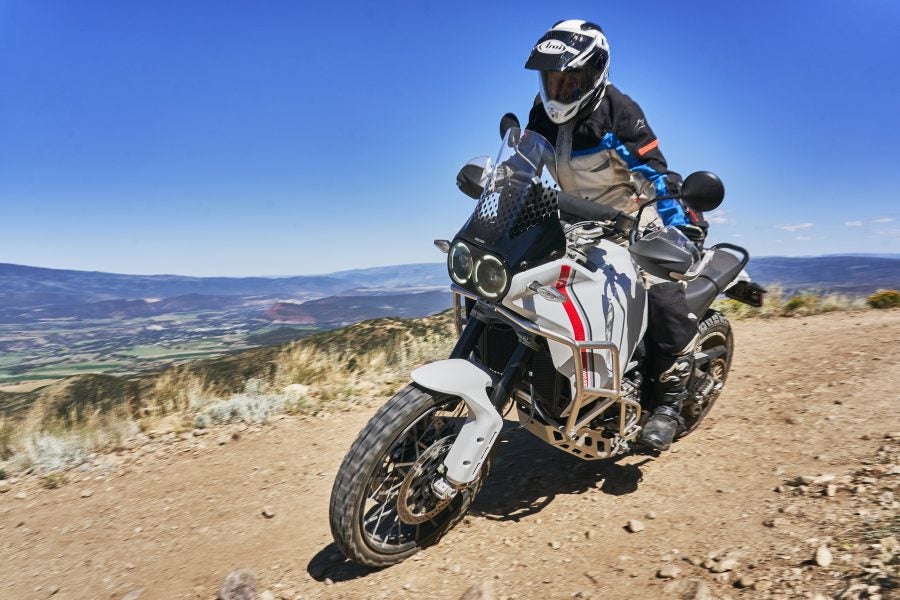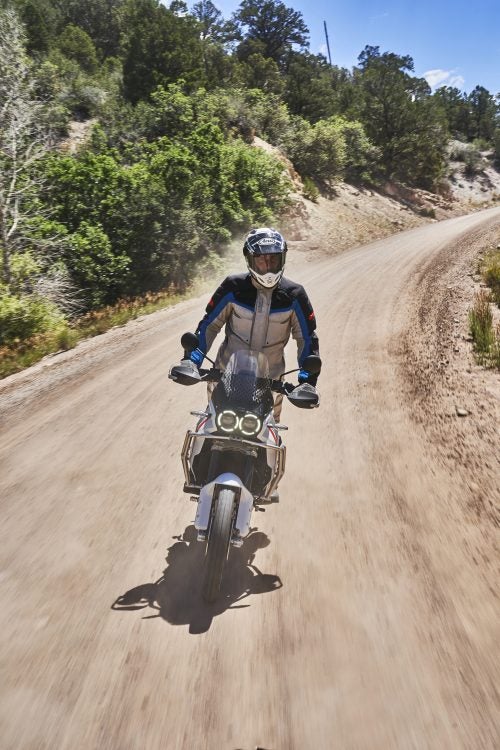Costa Mouzouris returns to ADVrider with a review of the latest Italian adventure bike—Ed.
Photos by Gregor Halenda and Scott Rounds
SNOWMASS, Colorado — I keep a list of all the motorcycles I’ve owned over the years, and a recent count revealed that there have been more than 40 from American, British, French, German, Japanese, and Italian bike makers. I also include a little descriptive anecdote in that list, reminding me of what each machine meant to me. Although I’ve owned at least two motorcycles from almost each manufacturer that has graced my garage, I’ve owned but one Italian bike: A 1999 Ducati 996 bought new, and the descriptive passage stated only that it was, “my fetish bike.”

The DesertX engine is retuned from its configuration in other more street-friendly models. Photo: Ducati
Having ridden countless other new Ducatis since then, I’m often reminded why I had such an affection for the machine. Ducati is known mostly for its exotic supersport machines, sportbikes and naked bikes. When ridden on pavement, these bikes handle impeccably, exhibiting the knowledge amassed from a company that has 14 World Superbike championships and two MotoGP championships under its belt.
Enter the all-new Ducati DesertX, a paradoxical Italian machine designed to ride hard after the pavement ends. The DesertX looks like it’s ready to tackle the Dakar Rally, boasting a rally-inspired fairing, long-travel suspension, and off-road-ready 21- and 18-inch wheel sizes. This seems an unusual departure for a company that was the first to put winglets onto MotoGP bikes, but Ducati actually has some off-roading lineage, though it does date from a while ago. Back in 1990, Italian rider Edi Orioli won the grueling Paris-Dakar rally aboard a Cagiva Elefant, a feat he repeated in 1994. Ducati was under Cagiva Group ownership from 1985 to 1996, so the Elefant was therefore powered by a 900 cc Ducati V-twin.
- Photo: Ducati
- Photo: Ducati
- Photo: Ducati
- Photo: Ducati
Technical details
Ducati first revealed a DesertX concept at EICMA in 2019, based on the Scrambler 1100. The production bike, though, is an entirely new machine from the ground up. Its engine is based on the liquid-cooled, 937 cc V-twin that also powers the Monster, Hypermotard, Multistrada V2 and Supersport, and not on the Scrambler’s air-cooled 1,079 cc mill. It claims 110 horsepower and 68 lb.-ft. of torque, and power delivery is broad and flat. Valve-adjustment intervals are set at 18,000 miles.
然而,杜卡迪的D引擎esertX. Changes include dedicated ride modes, and shorter transmission gearing; first through fifth of six gears are shorter, (sixth isn’t altered for highway riding). First and second gears are particularly short (14.3 and 8.7 percent shorter respectively than on the Multistrada V2.), to handle tighter off-road sections.
The engine hangs in a steel trellis frame, with fully adjustable Kayaba suspension that includes a 46-mm upside-down fork, and single shock with a handy remote preload knob located on the right side of the bike, just below the seat. Claimed wet weight is 492 lbs.
- More power, better suspension than anything currently in the Scrambler series. Photo: Ducati
- Our press bikes were pre-farkled, in case of a tip-over on the trails. Photo: Ducati
The bike boasts an impressive 9 inches (230 mm) of suspension travel up front and 8.7 inches (220 mm) in the rear. The tall suspension provides 9.8 inches (250 mm) of ground clearance, but it also makes the bike tall. Seat height is 34.4 inches (875 mm), though it can be dropped to 34.1 inches (865 mm) with an optional low seat ($308). You can drop it further, to 33.3 in. (845 mm), by combining the low seat with a lowering kit that includes fork and shock springs and a shorter side stand ($300). If you’re a giant, a taller seat is also available that raises height to 34.6 in. (880 mm).
The 5-inch TFT instrument display is supposed to be easier to read while standing up off-road, while providing a better display when using the optional Bluetooth-enabled navigation through your phone. Lean-sensing ABS and traction control, wheelie control, adjustable engine braking, cruise control, and a quick shifter are all standard. The DesertX has four road modes (Sport, Touring, Urban, Wet) and two off-road modes (Enduro and Rally), as well as four power levels, all selectable via the instrument panel. Enduro mode limits output to 75 horsepower, sets throttle response to dynamic, shuts off wheelie control, and reduces ABS intervention to level 2 (of three, rear ABS disabled) and traction-control to level 3 (of eight).
- You can definitely push the DesertX a lot further than previous Duc adventure machines. Photo: Ducati
- Pirelli Scorpion STR tires come standard. Photo: Ducati
The Desert X comes standard with Pirelli Scorpion Rally STR tires, which are great on hard-packed and moderately soft dirt, and they’re surprisingly grippy and vibration-free grip on pavement. From previous experience though, I can say they’re not very good in sand and mud, but Ducati has approved other rubber for that. You can opt for the aggressively treaded Scorpion Rally for more extreme off-road excursions, or for the more street-oriented Scorpion Trail II tires if you plan to stay primarily on pavement (please don’t…)
The fuel tank holds 5.5 gallons, but if you plan on traveling to more remote locations, Ducati offers an auxiliary 2.1-gallon tank ($1,500) that installs at the rear of the bike. The rider can switch the tank on to pump the extra fuel into the main tank after being prompted to do so via the instrument panel.
The Ride
Our 85-mile test route took us along some winding trails and dirt roads meandering their way through the mountains surrounding Aspen, Colorado. Within minutes after we hit the dirt, the DesertX asserted itself more as a proper dual sport machine rather than a ponderous adventure bike. It proved more than capable of handling serious off-road excursions along the rough and rocky, and in places quite steep trails.
Our hosts had accessorized our test bikes, firstly to showcase a few of the goodies available from Ducati, but also to help protect the bikes from damage, since our test loop was quite challenging. Accessories included crash bars ($700), a larger skid plate ($500, mounted solidly to the frame via brackets, rather than to the engine cases), and a Termignoni slip-on muffler (price N/A).

That vertically-stacked dash is supposed to be easier to read. Photo: Ducati
My preferred off-road setting was Rally, which drops ABS intervention to minimum (still disabled at the rear), and TC to level 2, though even this setting wasn’t ideal for a really quick pace. Fortunately, all six ride modes are individually customizable, so I turned traction control off and selected the softer throttle setting than the standard dynamic setting.
My only gripe with the ride modes is with the way they are selected. You have to hold down the mode button on the left-hand switch assembly for a couple of seconds to prompt the mode selection menu in the instrument panel, then scroll to the desired mode, then hit the mode button again, and then shut the throttle to confirm your selected mode. With practice it can be done in a matter of seconds while riding, but it’s a distracting and tedious process that can be simplified. At least the bike retains its selected ride modes anytime the ignition switch is turned off and on again.
With this tailored Rally setting selected, the rear end slid at will through corners, and the front wheel lifted effortlessly to clear obstacles. With elbows up and in attack mode, the DesertX ate rocks, bumps and ruts without flinching, keeping a solid, unwavering line, and easily steering around obstacles. It truly felt like a much lighter bike at speed than its weight would suggest. The front end felt solid, and the bike never shook its head, even after the front wheel got pounded by successive bumps at speed. The bike is equipped with a steering damper, so the stability isn’t surprising.

Rally raid looks, with 21st-century technology. Photo: Ducati
The suspension, which had been adjusted for my 220 pounds fully dressed, soaked up big dips and bumps without bottoming, with dirt-bike-like plushness. I did increase the rebound damping a couple of clicks at both ends, since the fork had topped out with a knock a couple of times as the wheel lifted off a few jumps, and the rear wallowed a bit when negotiating tight turning transitions — the bike behaved just fine after that.
DesertX真的印象深刻,然而,在很长一段,steep, rocky climb up a ski hill, on a switchback-riddled trail that brought us to an elevation of more than 11,300 feet. This is where the shorter gearing became an asset, especially the bottom two gears. The gap between first and second gears is a bit wide, though, prompting frequent gear changes when slowing for corner entry, though the bike’s quick shifter made this effortless.
On pavement, the DesertX showed off its Ducati-esque, road-going roots. At a quick pace, it railed though sweeping turns with confidence-inspiring stability. Its tall suspension makes turning transition ponderous, though, as it’s a long way up and then back down into a lean again. And due to its 21-inch front wheel and long-travel suspension, it prefers a deliberate, calculated approach to cornering, rather than a point-and-shoot, sportbike style — nail the twin M50 Brembos hard at corner entry and that long travel gets soaked up quickly. Overall, though, it will easily keep pace with sportbikes, especially if the pavement gets rough.

Costa was happy with the lower gearing on the DesertX, as it made hillclimbs in the Colorado mountains a lot easier. Photo: Ducati
The Ducati DesertX is a serious new entry in a category the Italian company has seemingly little experience with. It wavers into KTM, Husqvarna and Honda ADV bike territory, which is an unusual place to be for the Italian maker of sport bikes. But after thrashing it off road in challenging conditions, it has proven a worthy competitor that feels more like a dual-sport machine than a true adventure bike.
The Ducati DesertX is pricey, however, retailing for $17,095 US. The KTM 890 Adventure R retails for $14,599, the Husqvarna Norden 901 Husky for $13,999, and the Honda Africa Twin for $14,449. This might make the choice a difficult one, but one thing is for sure: While Ducati might be new to this off-road business, the DesertX can easily go head-to-head with any of its competitors, especially (and surprisingly) so when the going gets really rough.
















